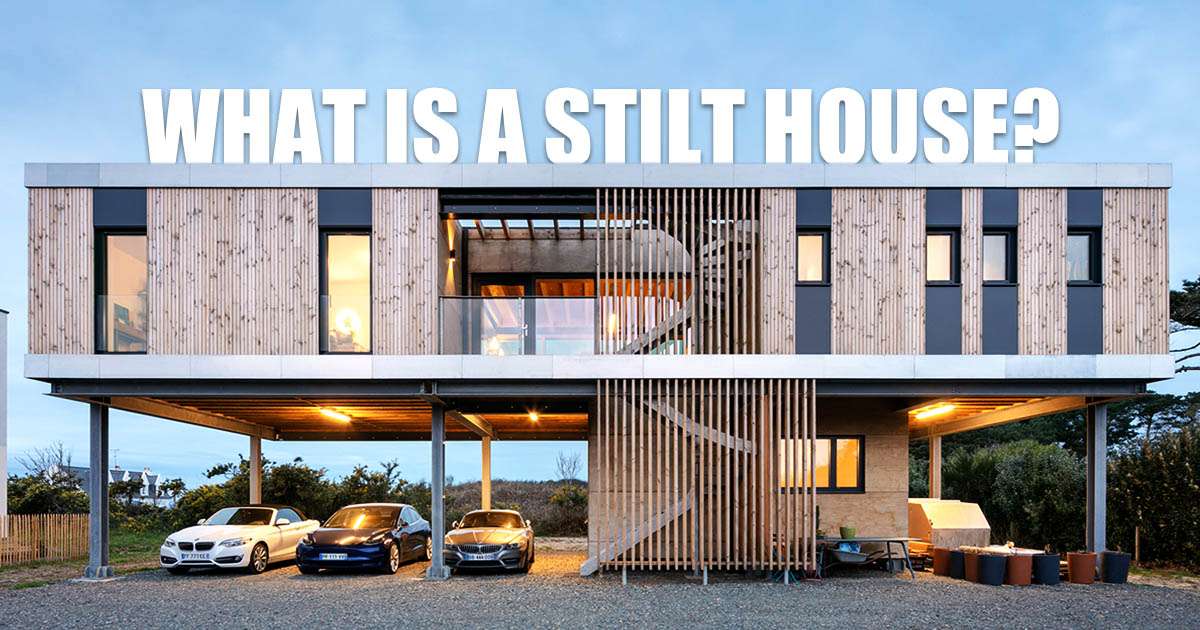What Is a Stilt House – A Comprehensive Exploration of Elevated Living

Stilt houses, also known as “pier houses” or “raised houses,” represent a fascinating architectural phenomenon with a rich history spanning centuries. Stilt houses are distinctive structures that stand above the ground, supported by stilts or pillars.
In this in-depth exploration, we’ll unravel the essence of stilt houses, delve into their historical importance, understand the reasons behind their construction, and even offer insights into building a house on stilts.
What Is a Stilt House?
A stilt house is a dwelling constructed above the ground, typically on wooden or concrete stilts or pillars. Depending on the specific environmental conditions and requirements, these stilts or pillars elevate the house several feet above the ground. Stilt houses are designed to withstand various natural elements, including floods, tsunamis, and uneven terrain.
There are many different kinds of stilt houses all over the world. Different cultures and regions have adapted this architectural concept to suit their needs and environmental challenges.
Some stilt houses are constructed over water bodies, such as lakes, rivers, or oceans, while others are built on land to mitigate flooding or offer a better view. The common thread among all stilt houses is their elevation above the ground on sturdy supports.
Why are houses built on stilts?
There are various compelling reasons for building buildings on stilts, which differ based on geographical location and environmental considerations. Let’s look at the specific reasons why these residences are built on stilts:
- Flood Mitigation: Stilt houses are often constructed in flood-prone areas to protect against rising water levels during rainy seasons or in low-lying coastal regions. Elevating the house on stilts keeps it safe and dry when floodwaters rise.
- Protection Against Tsunamis: Coastal regions prone to tsunamis often feature stilt houses. The elevation provides a buffer against the tsunami waves’ force, helping to protect the inhabitants.
- Ventilation and Cooling: Stilt houses provide natural ventilation and cooling in hot and humid climates. The space beneath the house allows air to flow, keeping the interior cooler and more comfortable.
- Enhanced Views: Houses on stilts built on higher ground have amazing views of the scenery around them. This makes them popular choices for vacation homes or homes in scenic locations.
- Protection from Wildlife: In some areas with wildlife threats, elevating a house on stilts can deter animals from entering the living space, providing an added layer of security.
- Preserving Ecosystems: Stilt houses over water bodies, like mangroves or coral reefs, help preserve fragile ecosystems by reducing the impact of construction on the environment.
- Cultural Significance: Some cultures have long-held customs and meanings tied to stilt houses. They may symbolize resilience, adaptability, or a connection to the natural world.
- Historical context: People have lived in houses on stilts for a long time. Studying them can provide insights into past civilizations’ architectural and engineering practices.
How to Build a House on Stilts
Building a house on stilts is a complicated process that requires careful planning, a lot of technical knowledge, and strict adherence to local building rules. This one-of-a-kind architecture method makes a house more resistant to environmental problems and adds a new level of complexity and creativity to the whole building process.
Here’s a much-needed guide on how to build a house on stilts:
1. Site Assessment: The Crucial First Step
Before the foundation is laid or the first stilt is erected, a thorough site assessment is imperative on how to build a house on stilts. This initial step involves a comprehensive evaluation of the chosen location. Factors such as soil type, geological stability, flood risk, and local building regulations are meticulously examined. Understanding the site’s specific characteristics is essential to inform subsequent design decisions and ensure the structure’s stability and safety.
2. Design and Permits: The Blueprint for Success
Architects and engineers must work together to create a plan for the stilt house that fits its surroundings. The design must accommodate the homeowner’s needs and preferences and consider the unique challenges of elevated construction.
At the same time, getting the necessary permits and approvals from local officials is important. Usually, this means showing that the suggested design follows zoning rules, building codes, and environmental laws. Navigating this administrative process is fundamental to the project’s success and legality.
3. Foundation: Laying the Groundwork for Stability
The foundation of a stilt house is a pivotal element. It serves as the primary support system for the entire structure. Various foundation types may be employed depending on the site’s characteristics, including concrete piers, piles, or columns. Each foundation type is carefully chosen to ensure stability and load-bearing capacity, considering factors such as soil conditions and the intended height of the stilts.
4. Structural Framework: Building the Backbone
The construction of the stilt house’s structural framework follows the foundation. This framework includes the load-bearing columns or stilts that elevate the house. Engineers and builders work together to ensure this framework is robust and perfectly aligned, ensuring the house’s stability and safety throughout its lifespan.
5. Flooring and Decking: Creating Usable Space
With the structural framework in place, the next step is installing the flooring and decking materials for the elevated platform. These materials, often treated wood or concrete, provide a solid and safe surface for interior and exterior spaces. The choice of materials should consider durability, aesthetics, and functionality.
6. Building the House: Realizing the Vision
Once the elevated platform is ready, construction of the house itself can commence. This phase involves building the walls, roof, and all interior and exterior features. Architects and builders pay particular attention to maximizing ventilation and minimizing heat transfer, as these factors can significantly impact the comfort and energy efficiency of the stilt house.
7. Utilities: Integrating Modern Comforts
Integrating utilities, including plumbing, electrical, and HVAC (heating, ventilation, and air conditioning) systems, is a crucial step in the construction process. These systems are carefully installed to ensure they function seamlessly and safely in an elevated environment. Compliance with building codes is paramount to guaranteeing the well-being of the occupants.
8. Safety Measures: Protecting the Inhabitants
During the building process, safety steps are taken to protect the people who will live there. These measures may include the installation of guardrails, staircases, and fire exits, among others. These safety features enhance the house’s safety profile and contribute to peace of mind for those residing in the stilt house.
9. Final Inspections: Ensuring Compliance
A thorough final inspection is conducted before the stilt house is ready for occupancy. These inspections, carried out by building officials, ensure the entire structure complies with safety and building codes. Any necessary changes or fixes are made to ensure the house meets the best standards for safety and quality.
Understand Better What is a Stilt House?
Over the years, stilt houses have been used for many things, from keeping people from flooding to giving people a wide view of nature landscapes. Anyone who is thinking about making a stilt house needs to know what they are, how they are built, why they are built, and the different types of stilt houses that are available.
Stick-built homes have always been a beautiful and useful way to live in flood-prone areas, protect ecosystems, or just show how flexible and creative people are. They also show how our relationship with the environment is always changing. Through creative engineering and design, stilt houses show that people can live in harmony with nature and change with it, while also making unique and long-lasting homes that fit in with their surroundings.

